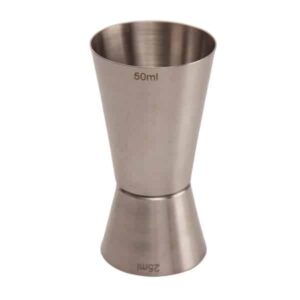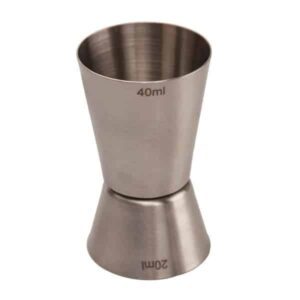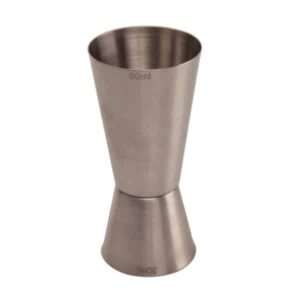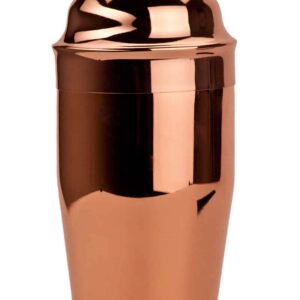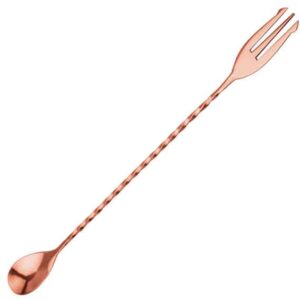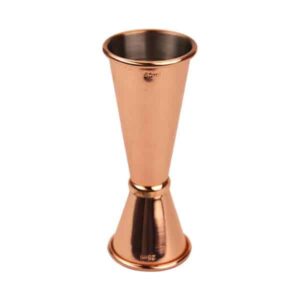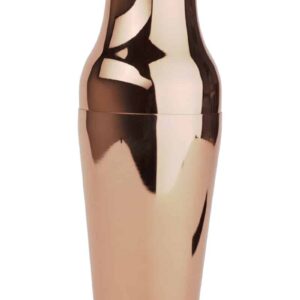Showing all 7 resultsSorted by popularity
Bar Equipment – The Complete Guide
TL;DR: In Brief
- Bar equipment is characterized by tools designed specifically for mixing, measuring, and serving drinks
- Made primarily from stainless steel, glass, and wood, defined by functionality and durability
- Found in several style categories, including mixing tools, glassware, and measurement instruments
- Best used according to specific cocktail requirements and can enhance experiences in classics like the Old Fashioned or modern mixology creations
Disclaimer: This guide is intended for informational purposes for adults over 18 years of age. Vault of Spirits encourages responsible alcohol consumption.
Introduction to Bar Equipment
Bar equipment has a rich history and fascinating craftsmanship behind it. From its origins in early taverns to its global popularity today, these tools have evolved to become some of the most valued items in drink culture.
This guide provides insight into the selection, use, and appreciation of bar equipment, whether you’re a beginner setting up your first home bar or an experienced enthusiast looking to refine your collection.
How Did Bar Equipment Evolve?
From Past to Present
The history of bar equipment traces back to ancient civilizations where vessels for serving fermented beverages were crafted from clay, wood, and precious metals.
The modern concept of specialized bar tools began taking shape in the 19th century with the rise of cocktail culture in America and Europe.
As drinks became more sophisticated, so did the tools needed to create them, leading to innovations like the Boston shaker and Hawthorne strainer we recognize today.
Which Historical Milestones Shaped Bar Equipment?
The prohibition era (1920-1933) significantly influenced bar equipment design, as bartenders needed more discreet and portable tools.
The post-WWII era saw standardization of many bar tool designs that remain virtually unchanged today.
The craft cocktail renaissance of the early 2000s brought renewed interest in both vintage equipment and innovative new designs, elevating barware from purely functional to status symbols.
How Has Bar Equipment Influenced Cultural Traditions?
In Japan, the art of bartending elevated bar equipment to ritual objects, with meticulous attention to detail in tool selection and use.
The ceremonial preparation of drinks in Cuba using specific wooden muddlers and specialized sugar spoons became integral to their cultural identity.
In modern cocktail culture, the visible use of high-quality bar equipment has become part of the theater of drink-making, enhancing the overall experience.
Why Is Bar Equipment Popular Today?
The rise of home cocktail culture, accelerated during global lockdowns, has created unprecedented demand for professional-quality bar equipment.
Social media has transformed bar tools into lifestyle accessories, with aesthetically pleasing designs becoming as important as functionality.
Growing appreciation for craft cocktails has educated consumers about the importance of proper tools in achieving professional results.
What Comprises Essential Bar Equipment?
Which Materials Are Used in Manufacturing?
Bar equipment utilizes various materials, each chosen for specific properties that enhance functionality and durability.
Primary materials:
- Stainless Steel – Provides durability, resistance to corrosion, and a neutral surface that won’t affect flavors
- Glass – Offers transparency for visual assessment and doesn’t retain flavors or odors
- Wood – Supplies warm aesthetics, comfortable grip, and traditional appeal for items like muddlers
How Do Mixing Tools Function?
Mixing tools operate on principles of physics and ergonomics to efficiently combine ingredients, chill mixtures, and create proper dilution.
The shaking action in cocktail shakers creates microbubbles that affect texture while rapidly chilling and diluting the drink.
Stirring tools work more gently, preserving clarity while still achieving proper temperature and dilution for spirit-forward cocktails.
Which Techniques Require Specialized Equipment?
Different bartending techniques have spawned specialized tools designed to optimize results.
Common specialized equipment:
- Shaking – Boston shakers and cobbler shakers for aeration and rapid chilling
- Straining – Hawthorne strainers, fine mesh strainers, and julep strainers for different filtration needs
- Muddling – Wooden and plastic muddlers for extracting flavors without bitterness
What Significance Does Glassware Hold?
Glassware is as critical to the drinking experience as the mixing equipment is to preparation.
The shape of glassware affects aroma concentration, temperature maintenance, and even how the liquid hits different parts of the palate.
Different cocktail families have traditionally associated glassware that has evolved to enhance their specific qualities.
Which Categories Define Bar Equipment?
What Are the Essential Tool Categories?
Bar equipment can be divided into several functional categories that form the foundation of any well-equipped bar.
Mixing tools include shakers, mixing glasses, and bar spoons that form the core of cocktail preparation.
Measurement tools such as jiggers and measuring cups ensure consistency and balance in drink recipes.
Preparation tools like muddlers, citrus presses, and knives facilitate ingredient processing before mixing.
How Do Regional Preferences Affect Equipment Selection?
Japanese bartending favors highly specialized tools with exacting standards, like hand-carved ice picks and precision jiggers.
American bar traditions typically embrace versatile, rugged tools like the Boston shaker and weighted bar spoons.
European traditions often incorporate regional specialties, such as absinth spoons in France or ginjinha glasses in Portugal.
What New Trends Are Emerging in Bar Equipment?
Sustainability has become a major focus, with eco-friendly materials and practices reshaping tool design and manufacturing.
Technology integration is growing, with digital scales, temperature-controlled mixing vessels, and app-connected tools entering the market.
Customization and personalization of bar tools has expanded, with artisanal makers offering bespoke items for both professional and home bartenders.
What Do Different Quality Designations Mean?
Professional-grade equipment typically offers superior durability, precision, and ergonomics compared to consumer-level alternatives.
Bar equipment may carry NSF certification in commercial settings, indicating it meets food safety standards.
Artisanal or handcrafted designations often indicate smaller production runs with greater attention to detail, but may lack standardization.
How Do You Select the Right Bar Equipment?
What Characterizes High-Quality Bar Tools?
Premium bar equipment typically features seamless construction, balanced weight, and thoughtful ergonomics that enhance functionality.
Typical quality indicators:
- Material Integrity – High-grade stainless steel, weighted bases, and seamless construction
- Precision Engineering – Exact measurements, perfect balance, and smooth operation
- Thoughtful Design – Ergonomic grips, intuitive use, and considered aesthetics
How Do Equipment Choices Vary Between Styles?
Classic bartending typically relies on tried-and-true standards like two-piece Boston shakers and Hawthorne strainers.
Molecular mixology often requires specialized equipment such as whipping siphons, smoke infusers, or sous vide machines.
Tiki bartending has its own unique tool requirements, including specialized swizzle sticks, specific glassware, and garnishing tools.
How Does Equipment Develop With Experience?
Beginners often start with basic, multifunctional tools that offer versatility without overwhelming complexity.
As skills develop, bartenders typically invest in more specialized tools that allow for precise technique execution.
Expert bartenders often develop personal preferences for specific tool variations that complement their unique style and techniques.
What Signs Reveal Professional Quality?
Professional-grade equipment frequently features heavier construction that withstands constant use in demanding environments.
Tool balance is carefully considered in high-quality items, making techniques like stirring or shaking more effortless and precise.
Material quality becomes evident over time, with superior items maintaining their appearance and functionality despite heavy use.
How Is Bar Equipment Best Utilized?
What Are the Optimal Usage Methods?
Each piece of bar equipment has specific techniques that maximize its effectiveness and protect its longevity.
Shakers should be held firmly but not over-tightened, with proper hand positioning to prevent leaking and ensure effective chilling.
Bar spoons require a specific rolling motion between the fingers to create smooth, efficient stirring without splashing.
Which Techniques Are Essential to Master?
Proper jiggering technique ensures accurate measurements, with the jigger held at eye level and filled precisely to the rim.
Effective straining requires holding the strainer flush against the shaker or mixing glass while controlling the flow rate.
Muddling should be done with controlled pressure – firm enough to release essential oils but gentle enough to avoid bitterness.
How Do Professionals Maintain Their Equipment?
Regular cleaning immediately after use prevents residue buildup that can affect flavors and functionality.
Proper drying is essential, particularly for wooden items which should never be left soaking, and metal tools which can spot if air-dried.
Periodic deep cleaning with non-abrasive cleaners helps maintain pristine condition and extend equipment lifespan.
Which Equipment Pairings Work Best Together?
Complementary tools are designed to work together, such as Hawthorne strainers that fit perfectly with Boston shaker tins.
Matching aesthetics across a bar set creates visual harmony and often indicates tools designed as a cohesive system.
Weight and balance consistency across tools can create a more intuitive workflow for the bartender.
Which Cocktails Showcase Equipment Technique?
Which Classic Cocktails Highlight Tool Mastery?
Several classic cocktails particularly demonstrate the importance of proper equipment and technique.
Old Fashioned
- Equipment: Muddler, mixing glass, bar spoon, strainer
- Preparation: The proper muddling of sugar with bitters, gentle stirring, and clean straining showcase fundamental techniques
- History: One of America’s oldest cocktails, highlighting the evolution of basic bar tools
Which Modern Cocktails Push Equipment Boundaries?
Contemporary cocktails often showcase innovative equipment applications that extend beyond traditional uses.
Smoking techniques utilize specialized equipment like smoke guns and sealed containers to infuse aromas into cocktails.
Clarified milk punch requires fine filtration equipment that demonstrates the importance of proper straining techniques.
How Is Equipment Featured in Service Presentation?
Tableside preparation often incorporates equipment as part of the visual experience, with tools becoming part of the theatrical presentation.
Specialized serving vessels like copper mule mugs or tiki ceramics demonstrate how the vessel itself becomes part of the equipment story.
Garnishing tools create final flourishes that complete the sensory experience of a cocktail.
Which Home Equipment Experiments Are Worth Trying?
Infusion experiments can be conducted with simple mason jars and strainers to create custom flavored spirits.
Ice programs can be developed at home with silicone molds and simple hand tools to enhance drink presentation and dilution control.
Syrup-making equipment allows experimentation with custom sweeteners that can transform standard cocktail recipes.
What Should You Know Before Purchasing Bar Equipment?
Which Details Should You Pay Attention to When Buying?
Material specifications matter significantly – look for 18/8 or 18/10 stainless steel for durability in tools that contact acidic ingredients.
Weight and balance should be assessed by handling tools before purchase whenever possible.
Manufacturing details like welded versus pressed construction can indicate quality differences and potential longevity.
What Do You Get in Different Price Ranges?
Entry-level bar sets ($30-75) typically offer basic functionality with less durable materials and construction.
Mid-range equipment ($75-200) provides significant quality improvements, professional-grade durability, and better ergonomics.
Premium tools ($200+) offer exceptional craftsmanship, unique designs, and often include artisanal or custom elements.
How Is Bar Equipment Properly Maintained?
Daily cleaning should involve warm soapy water for most tools, avoiding harsh detergents that can damage finishes.
Storage considerations include keeping tools dry, avoiding stacking that might cause damage, and protecting edges and tips.
Periodic maintenance might include polishing metal surfaces, conditioning wooden handles, or tightening components.
Is Quality Bar Equipment a Good Investment?
Professional-quality tools typically offer better value over time, with superior durability offsetting higher initial costs.
Vintage or collectible bar tools can appreciate in value, particularly items from notable manufacturers or historical periods.
Equipment that enhances technique precision can improve cocktail quality, providing value through the drinking experience itself.
Which Brands Do We Recommend?
What’s Best for Beginners?
Cocktail Kingdom offers reliable starter equipment with good quality-to-price ratios and comprehensive set options.
OXO bar tools provide affordable options with thoughtful design features that help beginners master techniques.
Barfly presents durable, straightforward tools that can withstand the learning process while providing professional-level functionality.
What Will Impress Enthusiasts?
Birdy by Erik Lorincz features exceptional craftsmanship with innovative design improvements on classic tools.
Umami Mart’s Japanese bartending tools offer precision engineering with beautiful aesthetics for discerning collectors.
Bull in China provides American-made artisanal quality with thoughtful design tweaks that experienced mixologists appreciate.
Which Items Are Most Coveted?
Vintage Napier silver-plated or sterling cocktail shakers from the Art Deco era represent both functional tools and investment pieces.
Hand-crafted Japanese mixing glasses from Umami Mart or Yukiwa command attention for their exceptional quality and rarity.
Limited edition collaboration pieces, such as Cocktail Kingdom’s partnerships with legendary bartenders, become instant collectibles.
Where Do You Get the Best Value for Money?
Koriko’s weighted shaking tins offer professional quality at reasonable prices, representing excellent value for everyday use.
Leopold’s weighted jiggers provide precision measurement with durability at mid-range price points.
Tojiro bar knives deliver Japanese cutting quality at accessible prices compared to other professional culinary brands.
Frequently Asked Questions
What Is Essential Bar Equipment?
Essential bar equipment includes the fundamental tools needed to prepare most cocktails: a shaker, jigger, bar spoon, strainer, and mixing glass.
These core items enable measuring, mixing, chilling, and serving techniques that form the foundation of cocktail preparation.
How Is Bar Equipment Selected?
Bar equipment selection should be based on the types of drinks you plan to make, your experience level, and your budget.
Quality considerations include material durability, ergonomic design, precision of measurement tools, and appropriate weight.
What Characterizes Quality Bar Equipment?
Quality bar equipment features seamless construction, appropriate weight and balance, precision measurements, and durable materials.
Professional-grade tools typically offer better ergonomics, longer lifespans, and more consistent performance than budget alternatives.
Where Can You Buy Bar Equipment?
Specialized cocktail supply retailers like Cocktail Kingdom, Umami Mart, and Bull in China offer curated selections of professional-quality tools.
General kitchenware stores like Williams-Sonoma and Sur La Table carry mainstream bar equipment with good quality standards.
Online marketplaces including Amazon provide convenient access to a wide range of options at various price points, though quality can vary significantly.
